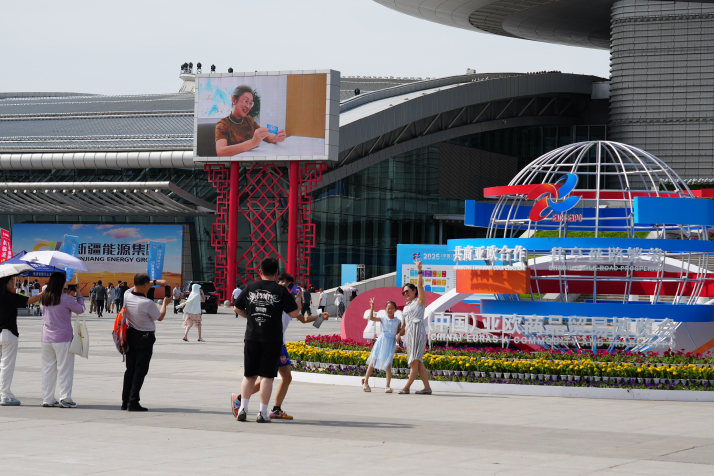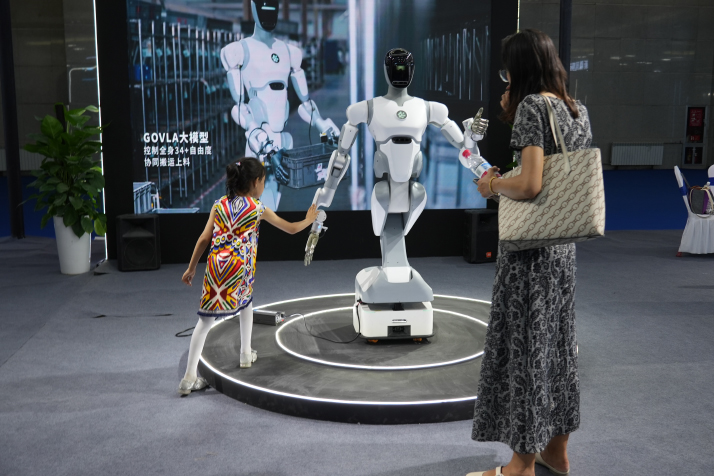| Business |
| More than an expo | |
|
|
 The 2025 (China) Eurasia Commodity and Trade Expo opens in Urumqi, capital city of Xinjiang Uygur Autonomous Region, on June 26 (LI FANGFANG)
For Iranian businessman Behzad Nouri, his first trip to Xinjiang Uygur Autonomous Region, one of northwest China's top summer vacation destinations, wasn't about sightseeing. It was about forging business ties at the 2025 (China) Eurasia Commodity and Trade Expo held in Urumqi, capital of Xinjiang, on June 26-30. Nouri has been doing business in China for several years and is based in Hangzhou, the country's e-commerce hub in the eastern province of Zhejiang. "The products we provide can be sold in bulk or retail," Nouri told Beijing Review. "This expo allows us to share what we have in Iran—our culture, our quality—and build connections that transcend commerce." Coming to connect At the expo, global merchants gathered to showcase their products and visions, reaffirming Xinjiang's central role in the Silk Road Economic Belt and China's promise that "its doors will only open wider to the world." The Silk Road Economic Belt and the 21st-Century Maritime Silk Road, both proposed by Chinese President Xi Jinping in 2013, are collectively known as the Belt and Road Initiative (BRI) and aim to boost connectivity along and beyond the ancient Silk Road routes. "This year's event has surpassed all previous editions in terms of international participation and scale," said Fu Yunyan, Director of the Xinjiang International Expo Affairs Administration. The numbers speak for themselves: Over 2,800 enterprises from 50 countries across Asia, Africa, Latin America and elsewhere participated, including first-time exhibitors from countries like Ethiopia, Zambia, Comoros and Senegal. Ethiopia, Belarus, Pakistan and 24 other countries set up national or regional pavilions, showcasing their exclusive resources and development achievements. Evolving from a regional trade fair in the 1990s, the expo has grown into a biennial anchor for Xinjiang's connectivity under the BRI. This year's edition featured 65 trade and investment events. Contracts worth over 417 billion yuan ($58 billion) were signed, encompassing 365 economic and trade cooperation projects. On-site sales totaled 1.89 billion yuan ($263 million), with a further 3.25 billion yuan ($453 million) in preliminary agreements. The key project signing event on June 27 secured a combined investment of 213.3 billion yuan ($30 billion), with 90 percent directed toward secondary industries like advanced manufacturing and energy transition. The openness of the expo was palpable. British YouTuber Luke Johnston, who has been living in Urumqi for six months, was surprised by the enthusiastic international turnout. "It's fascinating to see so many foreigners come here, eager to do business. They all loved it!" Johnston shared in a recent post on X. Purchasers from around the world tried Chinese products, exchanged contacts and explored partnerships. "What's your WeChat?" became a common refrain at booths, highlighting the seamless blend of modern communication with traditional networking. Internationally known as WeChat, Weixin is China's dominant super app—a multifunctional platform combining messaging, social media, mobile payments and lifestyle services into one integrated ecosystem. "This year's participation exceeded expectations," remarked Yao Zhenlei, Deputy Secretary General of the Shenzhen Electronic Chamber of Commerce, on the second day of the expo. The Shenzhen delegation, organized by the chamber, consisted of 28 enterprises, showcasing cutting-edge technologies in sectors like the digital economy, smart wearables and AI. "Our focus is on tapping into market opportunities in west China and Central Asia," Yao explained to Beijing Review. "Many of our member companies have already connected with potential clients, most of whom are from overseas."  Technological innovation emerged as a major highlight of the 2025 (China) Eurasia Commodity and Trade Expo, drawing significant attention from visitors (LI FANGFANG)
Green energy Gresgying, an electric vehicle (EV) charging solution provider from Xianyang in Shaanxi Province, a prominent stop on the ancient Silk Road, participated in the expo for the first time this year. The company wants to reimagine the ancient Silk Road through a green energy lens, leveraging Xinjiang's abundant wind and solar resources. "We're not only supporting renewable energy consumption but also driving the development of related industrial chains," said Bu Huaijin, marketing director of Gresgying. The company is dedicated to the research and development, production, sales and services of EV charging station devices, energy storage systems, microgrid systems and energy management systems. Gresgying can offer solutions for public fast charging hubs, electric heavy trucks and solar-powered charging systems based on Xinjiang's specific scenarios, Bu explained. "Our goal is to build strategic partnerships with Xinjiang enterprises, jointly investing in and operating a public charging network across the region," said Zhao Qing, Vice President of Gresgying. The company showed particular interest in developing integrated energy stations along highways and in transportation hubs, scenic spots and logistics parks. These stations combine photovoltaic power generation, energy storage and charging capabilities—known as solar-storage-charge-discharge systems—and are pivotal in Xinjiang's green transportation infrastructure. For renewable energy enterprises, Xinjiang, which is actively promoting their clustering, offers up both a vast untapped market and a vital gateway for Belt and Road cooperation, Zhao added. Showcasing local strengths The expo also spotlighted Xinjiang's thriving industrial ecosystem, featuring 10 key clusters, including new power systems, renewable energy, advanced manufacturing, cotton and textile apparel, and grain and food processing. In the outdoor exhibition area, rows of manufacturing equipment neatly showcased Xinjiang's complete equipment manufacturing industrial chain—from core components to fully assembled vehicles. Behind this display lies a network of enterprises working in unison to advance the sector. Xinjiang Dadao Industrial, a leading equipment manufacturing company in the region, showcased an impressive product lineup, including 12-meter-long electric low-entry city buses, CT medical vehicles and drones. The low-entry city bus is designed to improve accessibility for seniors and passengers with mobility challenges, according to newspaper Xinjiang Daily, citing Zhao Tianxiang, Executive Vice General Manager of Dadao, as saying. The CT medical vehicle, a flexible mobile healthcare platform, is equipped with operating tables, UV disinfection lamps and customizable medical devices—including CT scanners and X-ray machines, aiming to expand diagnostic access in remote areas. In the agricultural machinery sector, Xinjiang Boshiran Intelligent Agricultural Machinery Co. Ltd., a leading industry benchmark, unveiled 10 strategic products slated for 2025 release. The company specializes in equipment for cotton production, grain farming, pasture management and forestry. With breakthroughs in full-scenario coverage and technological iteration, Boshiran is driving modernization in Xinjiang's agricultural sector. In 2024, Xinjiang solidified its position as a global leader in cotton production, yielding 5.69 million tons and accounting for more than 20 percent of the world's total output. The region's vast cotton plantations, coupled with widespread agricultural mechanization, have driven the rapid growth of the farming machinery market. Boshiran's innovations include cotton harvesters with fire detection systems and automatic row navigation, as well as a super-large axial-flow grain combine harvester with a feed rate of 18 kg per second. These latest machines drew interest from both domestic and international buyers, including visitors from Central Asia and Russia. Data from Urumqi Customs show that exports of Xinjiang-made cotton harvesters rose from 44 units in 2022 to 223 units in 2024, and in the first two months of 2025, this figure surged 350 percent year on year, according to Xinhua News Agency. Among the main export destinations are Central Asian countries, as well as Türkiye, Egypt and India. BR (Reporting from Urumqi, Xinjiang Uygur Autonomous Region) Copyedited by Elsbeth van Paridon Comments to ffli@cicgamericas.com |
|
||||||||||||||||||||||||||||
|